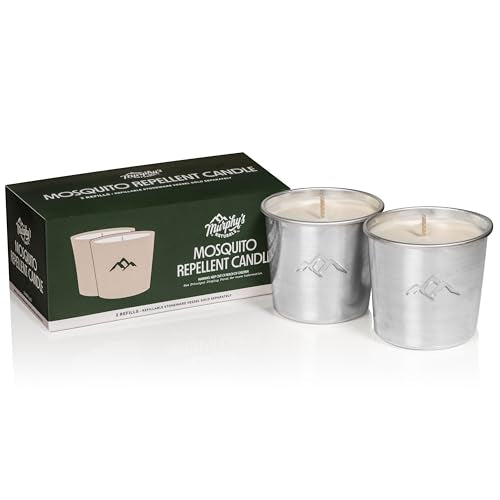
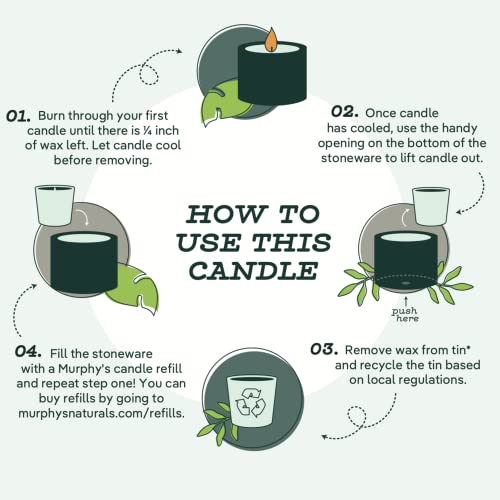
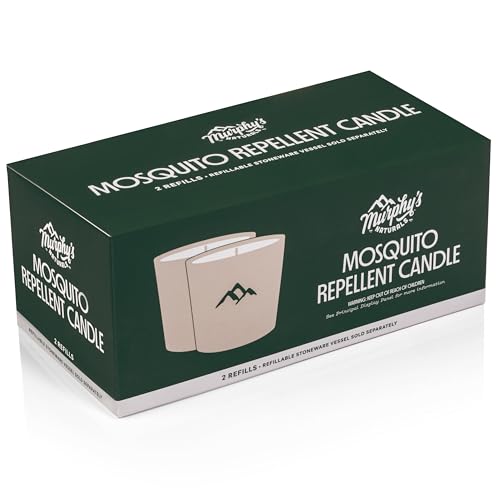

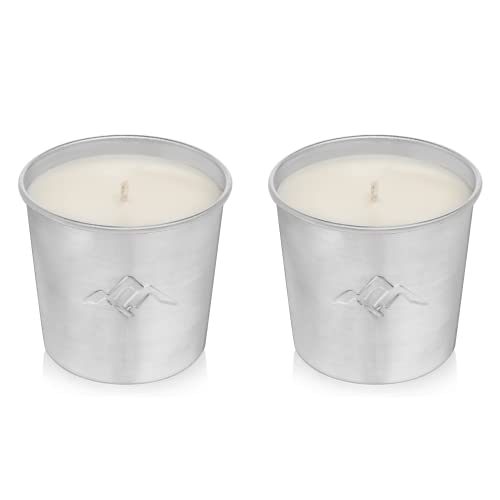
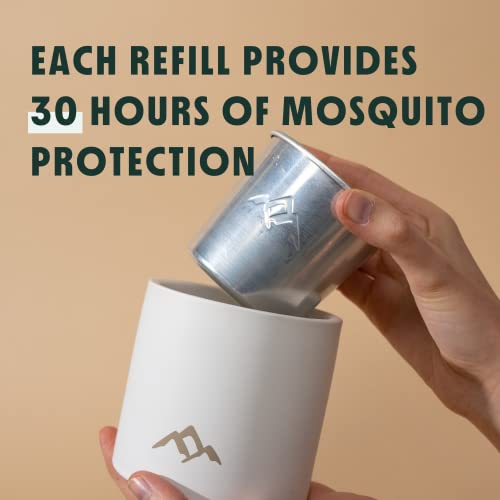
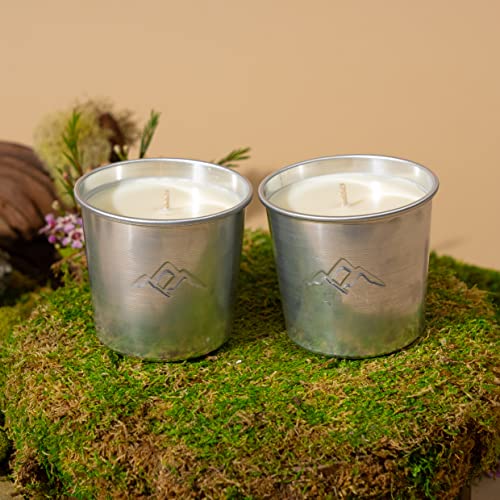

Murphy's Naturals Mosquito Repellent Candle Refills - Plant-Based Oils, Paraben-Free - 2x9oz


Cymbopogon Schoenanthus Oil
High RiskCymbopogon schoenanthus oil is a volatile oil derived from the leaves of the lemongrass plant, commonly used for its aromatic properties in cosmetics and personal care products. It serves primarily as a fragrance component but may also have antimicrobial properties.
Sustai Insights
Cymbopogon schoenanthus oil offers functional benefits as a fragrance and may contribute antimicrobial properties. However, it has a high allergenic potential, with concerns regarding enhanced skin absorption and potential irritancy. Regulatory bodies have imposed usage restrictions due to these risks. Overall, the ingredient presents a high risk level, necessitating caution in its application, especially for sensitive populations. Alternatives with lower allergenic profiles could be considered in formulation.
Rosmarinus Officinalis (Rosemary) Leaf Oil
Medium RiskRosmarinus officinalis (rosemary) leaf oil is extracted from the leaves of the rosemary plant. It is commonly used in cosmetic and personal care products for its aromatic properties and potential preservative benefits due to its antioxidant content.
Sustai Insights
Rosemary leaf oil offers functional benefits such as antimicrobial and antioxidant properties, which can enhance product stability. It is derived from a renewable source and is biodegradable. However, it presents moderate risks of allergic reactions and skin irritation, particularly with enhanced skin absorption. Regulatory bodies have noted restrictions on its usage in specific concentrations. The overall risk level is assessed as medium. Users are advised to follow safe usage practices and may consider alternatives like tocopherols or other natural preservatives.
Hydrogenated Soybean Oil
Low RiskHydrogenated soybean oil is an end product of the hydrogenation process applied to soybean oil, resulting in a semi-solid fat. It is commonly used in food products and cosmetics for its emulsifying and stabilizing properties.
Sustai Insights
Hydrogenated soybean oil provides effective emulsification and stability in products. It is generally recognized as safe, with low concerns regarding carcinogenicity, allergies, and reproductive toxicity. However, it may pose environmental risks if improperly disposed of, and there are regulatory restrictions on certain uses. Overall, the risk level is assessed as low, and safe usage practices should be followed. Alternatives may include non-hydrogenated oils that offer similar functional benefits.
Citronella
Low RiskCitronella is an essential oil derived from the leaves and stems of different species of Cymbopogon. It is commonly used as a fragrance in personal care products and as a natural insect repellent due to its distinct scent and properties.
Sustai Insights
Citronella is valued for its effective insect-repelling properties and pleasant fragrance, contributing to its use in various consumer products. It is generally considered safe, with low concerns regarding carcinogenicity, allergies, and reproductive toxicity. However, there are minor potential irritations for sensitive individuals. Environmentally, it poses low risks of pollution and bioaccumulation. Regulatory bodies have not placed significant restrictions on its use. Overall, the ingredient is assessed to have a low risk profile, making it a suitable option in formulations.
Mentha Piperita (Peppermint) Oil Extract
Low RiskMentha piperita (peppermint) oil extract is derived from the peppermint plant and is commonly used in various products for its aromatic and flavoring properties. It serves multiple functions, including acting as a fragrance agent and providing a cooling sensation in topical applications.
Sustai Insights
Mentha piperita oil offers functional benefits such as flavor enhancement and a refreshing aroma, while it is generally recognized as low risk for health concerns, including carcinogenicity and allergies. Environmentally, it does not contribute significantly to pollution or bioaccumulation. Regulatory bodies do not impose restrictions on its use. Safe usage practices include avoiding excessive exposure, particularly for sensitive individuals. Alternatives like spearmint oil may be considered, but overall, this ingredient is assessed as low risk.
Beeswax, Yellow
Low RiskBeeswax, yellow, is a natural wax produced by honeybees, primarily composed of esters of fatty acids and long-chain alcohols. It serves as an emulsifier, thickener, and stabilizer in cosmetic formulations, contributing to texture and consistency. It is commonly used in creams, balms, and lip products.
Sustai Insights
Beeswax provides functional benefits such as enhancing product texture and acting as a natural emulsifier, while also being biodegradable and sustainably sourced. Health risks are minimal, with low concerns for carcinogenicity, allergies, or irritations. Environmental impacts are also low, as it does not bioaccumulate. Regulatory status remains favorable with no current restrictions. Overall, the ingredient poses low risk, making it a suitable choice in cosmetic formulations.
Cedarwood Oil
Low RiskCedarwood oil is an essential oil derived from cedar trees, primarily used for its aromatic properties and as a natural ingredient in personal care products. It serves various functions, including acting as a fragrance, a potential preservative, and an insect repellent.
Sustai Insights
Cedarwood oil offers functional benefits, such as providing a pleasant scent and potential preservation properties due to its antimicrobial effects. It is sustainably sourced and biodegradable. Health-wise, it has low concerns regarding carcinogenicity, allergies, and reproductive toxicity. Environmentally, it poses low risks as a pollutant and is not bioaccumulative. Regulatory bodies have not issued significant warnings, confirming its low-risk status. Safe usage practices should be followed, and alternatives include plant-based essential oils with similar benefits. Overall, cedarwood oil is assessed with a low risk level.
Hydrogenated Soybean Oil
Low RiskHydrogenated soybean oil is an end product of the hydrogenation process applied to soybean oil, resulting in a semi-solid fat. It is commonly used in food products and cosmetics for its emulsifying and stabilizing properties.
Sustai Insights
Hydrogenated soybean oil provides effective emulsification and stability in products. It is generally recognized as safe, with low concerns regarding carcinogenicity, allergies, and reproductive toxicity. However, it may pose environmental risks if improperly disposed of, and there are regulatory restrictions on certain uses. Overall, the risk level is assessed as low, and safe usage practices should be followed. Alternatives may include non-hydrogenated oils that offer similar functional benefits.
Citronella
Low RiskCitronella is an essential oil derived from the leaves and stems of different species of Cymbopogon. It is commonly used as a fragrance in personal care products and as a natural insect repellent due to its distinct scent and properties.
Sustai Insights
Citronella is valued for its effective insect-repelling properties and pleasant fragrance, contributing to its use in various consumer products. It is generally considered safe, with low concerns regarding carcinogenicity, allergies, and reproductive toxicity. However, there are minor potential irritations for sensitive individuals. Environmentally, it poses low risks of pollution and bioaccumulation. Regulatory bodies have not placed significant restrictions on its use. Overall, the ingredient is assessed to have a low risk profile, making it a suitable option in formulations.
Cymbopogon Schoenanthus Oil
High RiskCymbopogon schoenanthus oil is a volatile oil derived from the leaves of the lemongrass plant, commonly used for its aromatic properties in cosmetics and personal care products. It serves primarily as a fragrance component but may also have antimicrobial properties.
Sustai Insights
Cymbopogon schoenanthus oil offers functional benefits as a fragrance and may contribute antimicrobial properties. However, it has a high allergenic potential, with concerns regarding enhanced skin absorption and potential irritancy. Regulatory bodies have imposed usage restrictions due to these risks. Overall, the ingredient presents a high risk level, necessitating caution in its application, especially for sensitive populations. Alternatives with lower allergenic profiles could be considered in formulation.
Mentha Piperita (Peppermint) Oil Extract
Low RiskMentha piperita (peppermint) oil extract is derived from the peppermint plant and is commonly used in various products for its aromatic and flavoring properties. It serves multiple functions, including acting as a fragrance agent and providing a cooling sensation in topical applications.
Sustai Insights
Mentha piperita oil offers functional benefits such as flavor enhancement and a refreshing aroma, while it is generally recognized as low risk for health concerns, including carcinogenicity and allergies. Environmentally, it does not contribute significantly to pollution or bioaccumulation. Regulatory bodies do not impose restrictions on its use. Safe usage practices include avoiding excessive exposure, particularly for sensitive individuals. Alternatives like spearmint oil may be considered, but overall, this ingredient is assessed as low risk.
Beeswax, Yellow
Low RiskBeeswax, yellow, is a natural wax produced by honeybees, primarily composed of esters of fatty acids and long-chain alcohols. It serves as an emulsifier, thickener, and stabilizer in cosmetic formulations, contributing to texture and consistency. It is commonly used in creams, balms, and lip products.
Sustai Insights
Beeswax provides functional benefits such as enhancing product texture and acting as a natural emulsifier, while also being biodegradable and sustainably sourced. Health risks are minimal, with low concerns for carcinogenicity, allergies, or irritations. Environmental impacts are also low, as it does not bioaccumulate. Regulatory status remains favorable with no current restrictions. Overall, the ingredient poses low risk, making it a suitable choice in cosmetic formulations.
Rosmarinus Officinalis (Rosemary) Leaf Oil
Medium RiskRosmarinus officinalis (rosemary) leaf oil is extracted from the leaves of the rosemary plant. It is commonly used in cosmetic and personal care products for its aromatic properties and potential preservative benefits due to its antioxidant content.
Sustai Insights
Rosemary leaf oil offers functional benefits such as antimicrobial and antioxidant properties, which can enhance product stability. It is derived from a renewable source and is biodegradable. However, it presents moderate risks of allergic reactions and skin irritation, particularly with enhanced skin absorption. Regulatory bodies have noted restrictions on its usage in specific concentrations. The overall risk level is assessed as medium. Users are advised to follow safe usage practices and may consider alternatives like tocopherols or other natural preservatives.
Cedarwood Oil
Low RiskCedarwood oil is an essential oil derived from cedar trees, primarily used for its aromatic properties and as a natural ingredient in personal care products. It serves various functions, including acting as a fragrance, a potential preservative, and an insect repellent.
Sustai Insights
Cedarwood oil offers functional benefits, such as providing a pleasant scent and potential preservation properties due to its antimicrobial effects. It is sustainably sourced and biodegradable. Health-wise, it has low concerns regarding carcinogenicity, allergies, and reproductive toxicity. Environmentally, it poses low risks as a pollutant and is not bioaccumulative. Regulatory bodies have not issued significant warnings, confirming its low-risk status. Safe usage practices should be followed, and alternatives include plant-based essential oils with similar benefits. Overall, cedarwood oil is assessed with a low risk level.
Experience the outdoors without the nuisance of mosquitoes with Murphy's Naturals Mosquito Repellent Candle Refills. This eco-friendly solution features plant-based essential oils in a sustainable soy and beeswax blend, ensuring an enjoyable and safe outdoor atmosphere.
- Natural Protection: Infused with rosemary, peppermint, citronella, lemongrass, and cedarwood oils, these candles provide effective mosquito repellent properties without harmful chemicals.
- Sustainable Design: Each refill comes in a recyclable aluminum container, reducing waste and promoting environmental responsibility.
- Long-lasting Burn: Enjoy up to 30 hours of burn time per candle, making it perfect for extended outdoor gatherings and activities.
- Easy to Use: Designed for the Murphy's Naturals refillable candle, simply swap out the old candle for a new one to maintain your mosquito-free zone.
- Health-Conscious Choice: Paraben-free, phthalate-free, and petroleum-free, these candles are a safe option for families and pets, ensuring peace of mind while you enjoy your outdoor space.
Subscribe & Save with Sustai
- Best Price Guarantee: Always enjoy the lowest prices on sustainable home essentials.
- No Surprises: We’ll notify you before shipping. No hidden fees, ever.
- You’re in Charge: Change, pause, or cancel your subscription anytime with ease.
- Eco-Friendly Deliveries: Our grouped shipments mean less packaging and lower emissions.
Join us on a sustainable journey. Special offers for a limited time! Prices and promotions may change.
Recommended Products
Experience the outdoors without the nuisance of mosquitoes with Murphy's Naturals Mosquito Repellent Candle Refills. This eco-friendly solution features plant-based essential oils in a sustainable soy and beeswax blend, ensuring an enjoyable and safe outdoor atmosphere.
- Natural Protection: Infused with rosemary, peppermint, citronella, lemongrass, and cedarwood oils, these candles provide effective mosquito repellent properties without harmful chemicals.
- Sustainable Design: Each refill comes in a recyclable aluminum container, reducing waste and promoting environmental responsibility.
- Long-lasting Burn: Enjoy up to 30 hours of burn time per candle, making it perfect for extended outdoor gatherings and activities.
- Easy to Use: Designed for the Murphy's Naturals refillable candle, simply swap out the old candle for a new one to maintain your mosquito-free zone.
- Health-Conscious Choice: Paraben-free, phthalate-free, and petroleum-free, these candles are a safe option for families and pets, ensuring peace of mind while you enjoy your outdoor space.

You can have at most 2 Sustainable Steals products in your cart
Customer Reviews
Customers’ View
Customers appreciate the effectiveness and eco-friendly nature of these candle refills. Many users have noted their long burn time of approximately 30 hours, making them a reliable choice for outdoor gatherings. The plant-based ingredients, including essential oils like rosemary and citronella, resonate well with health-conscious consumers seeking natural solutions. For instance, one reviewer highlighted how these candles kept mosquitoes at bay while enjoying their patio, and another mentioned the pleasant scent. While the majority of feedback is positive, some customers raised concerns about the wick not reaching the bottom of the candle, affecting burn duration. Overall, customers find these refills to be both effective in repelling insects and aligned with sustainable practices.
AI-generated from the text of customer reviewsThis product has no reviews yet.




